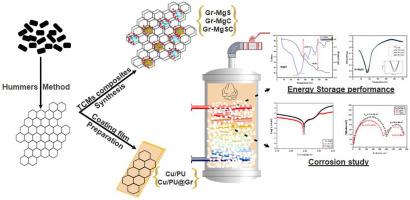当前位置:
X-MOL 学术
›
Sol. Energy Mater. Sol. Cells
›
论文详情
Our official English website, www.x-mol.net, welcomes your feedback! (Note: you will need to create a separate account there.)
New hybrid graphene/inorganic salt composites for thermochemical energy storage: Synthesis, cyclability investigation and heat exchanger metal corrosion protection performance
Solar Energy Materials and Solar Cells ( IF 6.9 ) Pub Date : 2020-09-01 , DOI: 10.1016/j.solmat.2020.110601 Hanane Ait Ousaleh , Said Sair , Said Mansouri , Younes Abboud , Abdessamad Faik , Abdeslam El Bouari
Solar Energy Materials and Solar Cells ( IF 6.9 ) Pub Date : 2020-09-01 , DOI: 10.1016/j.solmat.2020.110601 Hanane Ait Ousaleh , Said Sair , Said Mansouri , Younes Abboud , Abdessamad Faik , Abdeslam El Bouari

|
Abstract Herein, new hybrid thermochemical materials (TCMs) combining MgSO4, MgCl2, and their mixture incorporated into the graphene matrix have been prepared for low to medium temperature heat storage applications. These new hybrid materials were developed to solve agglomeration, cyclability and corrosion issues during hydration/dehydration cycles. The preliminary results of X-Ray diffraction, Raman spectroscopy, and scanning electron microscopy confirmed that the inorganic salts were successfully impregnated into the matrix without providing undesirable reactions. Calorimetric analysis (DSC-TGA) revealed a significant improvement of cycling stability up to 60 hydration/dehydration cycles, and an excellent storage density of 1194.3 J/g and 890 J/g was reached for MgSO4 and MgCl2 composites respectively. In order to protect the heat exchanger metal from the TCMs behaviour, two coating films of polyurethane and polyurethane-graphene have been applied. The scanning electron microscopy showed the good dispersion of graphene into polyurethane film. The electrochemical measurements under storage reactor conditions were examined using conventional methods such as gravimetric tests, polarization techniques and electrochemical impedance spectroscopy (EIS). An inhibition efficiency up to ≈99% for coated metal was reached and suitable corrosion mechanism for uncoated and coated copper was proposed.
中文翻译:

用于热化学储能的新型混合石墨烯/无机盐复合材料:合成、循环性研究和换热器金属腐蚀防护性能
摘要 在此,新型混合热化学材料 (TCM) 将 MgSO4、MgCl2 及其混合物结合到石墨烯基体中,用于中低温储热应用。这些新的混合材料旨在解决水合/脱水循环过程中的团聚、循环性和腐蚀问题。X 射线衍射、拉曼光谱和扫描电子显微镜的初步结果证实,无机盐成功地浸渍到基体中,没有产生不希望的反应。量热分析 (DSC-TGA) 显示循环稳定性显着提高,最高可达 60 次水合/脱水循环,MgSO4 和 MgCl2 复合材料分别达到 1194.3 J/g 和 890 J/g 的优异存储密度。为了保护热交换器金属免受 TCM 行为的影响,已经应用了聚氨酯和聚氨酯-石墨烯两种涂层膜。扫描电子显微镜显示石墨烯在聚氨酯薄膜中具有良好的分散性。使用常规方法如重量测试、极化技术和电化学阻抗谱 (EIS) 检查在储存反应器条件下的电化学测量。涂层金属的抑制效率高达≈99%,并提出了未涂层和涂层铜的合适腐蚀机制。使用常规方法如重量测试、极化技术和电化学阻抗谱 (EIS) 检查在储存反应器条件下的电化学测量。涂层金属的抑制效率高达≈99%,并提出了未涂层和涂层铜的合适腐蚀机制。使用常规方法如重量测试、极化技术和电化学阻抗谱 (EIS) 检查在储存反应器条件下的电化学测量。涂层金属的抑制效率高达≈99%,并提出了未涂层和涂层铜的合适腐蚀机制。
更新日期:2020-09-01
中文翻译:

用于热化学储能的新型混合石墨烯/无机盐复合材料:合成、循环性研究和换热器金属腐蚀防护性能
摘要 在此,新型混合热化学材料 (TCM) 将 MgSO4、MgCl2 及其混合物结合到石墨烯基体中,用于中低温储热应用。这些新的混合材料旨在解决水合/脱水循环过程中的团聚、循环性和腐蚀问题。X 射线衍射、拉曼光谱和扫描电子显微镜的初步结果证实,无机盐成功地浸渍到基体中,没有产生不希望的反应。量热分析 (DSC-TGA) 显示循环稳定性显着提高,最高可达 60 次水合/脱水循环,MgSO4 和 MgCl2 复合材料分别达到 1194.3 J/g 和 890 J/g 的优异存储密度。为了保护热交换器金属免受 TCM 行为的影响,已经应用了聚氨酯和聚氨酯-石墨烯两种涂层膜。扫描电子显微镜显示石墨烯在聚氨酯薄膜中具有良好的分散性。使用常规方法如重量测试、极化技术和电化学阻抗谱 (EIS) 检查在储存反应器条件下的电化学测量。涂层金属的抑制效率高达≈99%,并提出了未涂层和涂层铜的合适腐蚀机制。使用常规方法如重量测试、极化技术和电化学阻抗谱 (EIS) 检查在储存反应器条件下的电化学测量。涂层金属的抑制效率高达≈99%,并提出了未涂层和涂层铜的合适腐蚀机制。使用常规方法如重量测试、极化技术和电化学阻抗谱 (EIS) 检查在储存反应器条件下的电化学测量。涂层金属的抑制效率高达≈99%,并提出了未涂层和涂层铜的合适腐蚀机制。



























 京公网安备 11010802027423号
京公网安备 11010802027423号